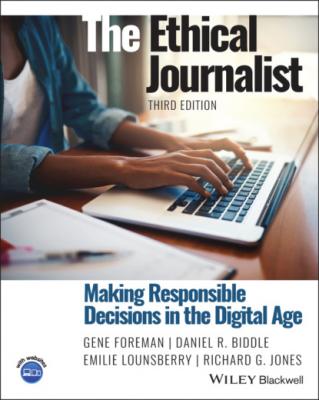The Ethical Journalist. Gene Foreman
Читать онлайн.| Название | The Ethical Journalist |
|---|---|
| Автор произведения | Gene Foreman |
| Жанр | Зарубежная деловая литература |
| Серия | |
| Издательство | Зарубежная деловая литература |
| Год выпуска | 0 |
| isbn | 9781119777489 |
A step-by-step template can guide you to a better decision.
You must test your decision to see if it can be defended.
In this course, approach the case studies as a laboratory exercise in decision-making.
Point of View: Avoid These Rationalizations (Michael Josephson)
Case Study: Deciding Whether to Identify a CIA Agent
Part II: Putting Journalism Ethics to Work
10 Getting the Facts Right and Being Fair
SPJ’s guiding principle of seeking truth and reporting it
Accuracy and fairness are journalism’s fundamental ethical values.
The digital era, with its emphasis on speed, entices reporters to take shortcuts and, thus, to risk mistakes.
Journalists have to be alert for hoaxes, especially on the web.
Problematic trends in the newsroom: less specialization, less editing.
Point of View: Declaring What You Wont Report (Craig Silverman)
Case Study: A Story of Rape at Mr. Jefferson’s University
Case Study: A Double Disaster at the Sago Mine
Case Study: Richard Jewell: He Really Was a Hero
Case Study: The Football Star’s Fictitious Girlfriend
11 Showing Empathy for People in the News
SPJ’s guiding principle of minimizing harm
Recognizing that the truth can hurt, journalists should weigh the information they are reporting against the harm it can be expected to cause. Sometimes that calculation might lead to a decision not to publish a detail of marginal relevance or possibly an entire story or photograph.
Requests from the public to “unpublish” archival content create an ethical dilemma: a desire to protect the historical record versus consideration of the people hurt by that record, especially when it is flawed.
Reporters should take particular care when interviewing children and survivors of a tragedy, or when reporting on suicides.
Journalists should be aware that their presence can be viewed as intrusive.
Case Study: The Death of a Boy
Point of View: Reporting a Fact, Causing Harm (William F. Woo)
12 Avoiding Conflicts: Appearances Count
SPJ’s guiding principle of acting independently
In an actual conflict of interest, journalists allow self‐interest, or a loyalty to any other person or organization, to take precedence over their duty to the audience.
Because a conflict of interest gives the audience reason to doubt the journalist’s loyalty, it undermines credibility.
An appearance of a conflict of interest can damage credibility even if the journalist’s reporting is honest.
By following reasonable guidelines, you can avoid most conflicts, actual or apparent.
Identifying situations that commonly lead to conflicts.
Case Study: A Reporter’s Son Joins a Foreign Army
Case Study: A Journalist’s Gifts to the Clinton Foundation
Case Study: The Columnist’s Other Job
Case Study: Carrying a Torch, Stirring Debate
13 Lifting the Curtain on How Journalism Is Done
SPJ’s guiding principle of being accountable and transparent
News organizations should correct their mistakes promptly, prominently, and clearly.
News organizations should have a system to invite, receive, and act on inquiries and complaints about news coverage.
News organizations should be willing to explain and discuss how they cover the news.
The audience can be a partner in reporting the news, but journalists have a duty to verify all user-generated content.
There are limits to journalistic transparency, including the question of whether reporter’s personal opinions should be revealed.
Point of View: A Digital Dialogue With Readers (Mark Bowden)
Case Study: Roughed Up at Recess
14 Navigating Social Medias Uneven Terrain
Connecting with the audience while maintaining impartiality
Using social media helps journalists report their stories and promote them. However, journalist’s comments about people and events in the news can damage their credibility and that of their news organizations.
Social media policies are a common source of tension in newsrooms, and enforcement of those policies has led to staff protests.
Point of View: Race, Gender, Social Media, and Power (Ingrid Sturgis)
Point of View: A Journalist’s Duty (Bob Steele)
Case Study: A Reporter’s Tweet Hits a Sour Note
15 Covering a Diverse, Multicultural Society
An ethical duty to be inclusive in news coverage and in the newsroom
Covering society’s diversity is an ethical responsibility, because news organizations have a duty to cover the entire community.
Careful, sensitive reporting is required to analyze the complex issues of racial and ethnic conflicts.
Journalists face challenges in their efforts to provide knowledgeable coverage of cultures other than their own.
Reporters who cover new immigrants are confronting ethics issues such as protecting the identity of sources who are not documented.
Point of View: Gaining Respect by Showing Respect (Joann Byrd)
16 Dealing With Sources of Information
The fine line between getting close and too close
Ethics issues arise in reporter’s efforts to cultivate sources while maintaining independence from those sources.
If a journalist agrees to protect a source who provides information on condition of anonymity, honoring that agreement is a solemn ethical duty.
Journalists must avoid placing their sources in any kind of jeopardy.
Beat reporting requires reporters to balance their relationships with newsmakers whom they depend on for information but also may have to report on critically.
Showing copy to sources and other situations in which ethics issues arise in source relationships.
Point of View: Sometimes, Different Rules Apply (Jeffrey Fleishman)
Case Study: The Strange Intercept at “The Intercept”
17 Making News Decisions About Privacy
The public may need to know what individuals want hidden
Journalists often must decide
